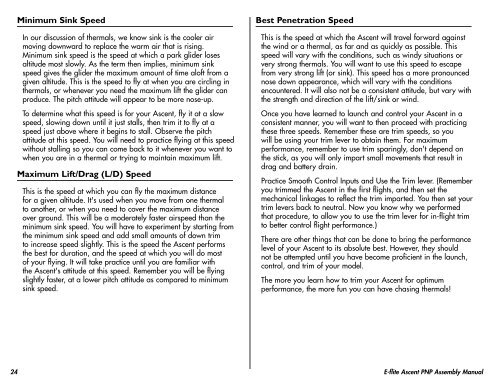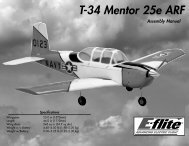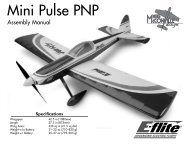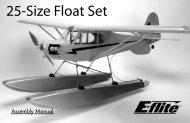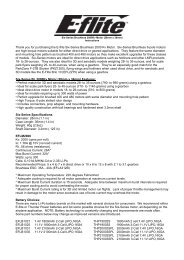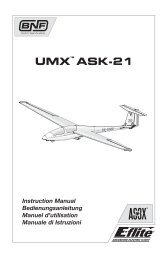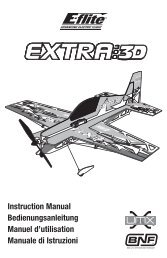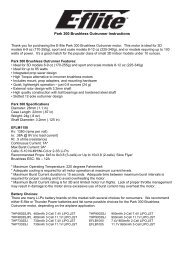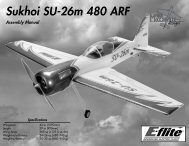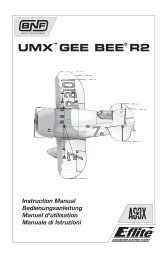Ascent 450 BL Park Glider PNP - E-flite
Ascent 450 BL Park Glider PNP - E-flite
Ascent 450 BL Park Glider PNP - E-flite
Create successful ePaper yourself
Turn your PDF publications into a flip-book with our unique Google optimized e-Paper software.
Minimum Sink Speed<br />
In our discussion of thermals, we know sink is the cooler air<br />
moving downward to replace the warm air that is rising.<br />
Minimum sink speed is the speed at which a park glider loses<br />
altitude most slowly. As the term then implies, minimum sink<br />
speed gives the glider the maximum amount of time aloft from a<br />
given altitude. This is the speed to fly at when you are circling in<br />
thermals, or whenever you need the maximum lift the glider can<br />
produce. The pitch attitude will appear to be more nose-up.<br />
To determine what this speed is for your <strong>Ascent</strong>, fly it at a slow<br />
speed, slowing down until it just stalls, then trim it to fly at a<br />
speed just above where it begins to stall. Observe the pitch<br />
attitude at this speed. You will need to practice flying at this speed<br />
without stalling so you can come back to it whenever you want to<br />
when you are in a thermal or trying to maintain maximum lift.<br />
Maximum Lift/Drag (L/D) Speed<br />
This is the speed at which you can fly the maximum distance<br />
for a given altitude. It's used when you move from one thermal<br />
to another, or when you need to cover the maximum distance<br />
over ground. This will be a moderately faster airspeed than the<br />
minimum sink speed. You will have to experiment by starting from<br />
the minimum sink speed and add small amounts of down trim<br />
to increase speed slightly. This is the speed the <strong>Ascent</strong> performs<br />
the best for duration, and the speed at which you will do most<br />
of your flying. It will take practice until you are familiar with<br />
the <strong>Ascent</strong>'s attitude at this speed. Remember you will be flying<br />
slightly faster, at a lower pitch attitude as compared to minimum<br />
sink speed.<br />
Best Penetration Speed<br />
This is the speed at which the <strong>Ascent</strong> will travel forward against<br />
the wind or a thermal, as far and as quickly as possible. This<br />
speed will vary with the conditions, such as windy situations or<br />
very strong thermals. You will want to use this speed to escape<br />
from very strong lift (or sink). This speed has a more pronounced<br />
nose down appearance, which will vary with the conditions<br />
encountered. It will also not be a consistent attitude, but vary with<br />
the strength and direction of the lift/sink or wind.<br />
Once you have learned to launch and control your <strong>Ascent</strong> in a<br />
consistent manner, you will want to then proceed with practicing<br />
these three speeds. Remember these are trim speeds, so you<br />
will be using your trim lever to obtain them. For maximum<br />
performance, remember to use trim sparingly, don't depend on<br />
the stick, as you will only impart small movements that result in<br />
drag and battery drain.<br />
Practice Smooth Control Inputs and Use the Trim lever. (Remember<br />
you trimmed the <strong>Ascent</strong> in the first flights, and then set the<br />
mechanical linkages to reflect the trim imparted. You then set your<br />
trim levers back to neutral. Now you know why we performed<br />
that procedure, to allow you to use the trim lever for in-flight trim<br />
to better control flight performance.)<br />
There are other things that can be done to bring the performance<br />
level of your <strong>Ascent</strong> to its absolute best. However, they should<br />
not be attempted until you have become proficient in the launch,<br />
control, and trim of your model.<br />
The more you learn how to trim your <strong>Ascent</strong> for optimum<br />
performance, the more fun you can have chasing thermals!<br />
24 E-<strong>flite</strong> <strong>Ascent</strong> <strong>PNP</strong> Assembly Manual


